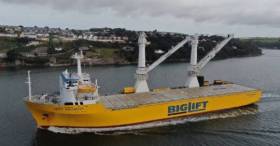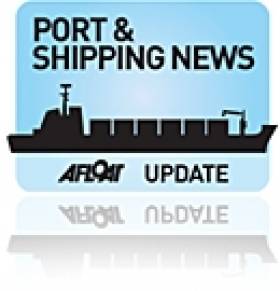Displaying items by tag: Heavylift ship
Harland & Wolff Group's Belfast shipyard has been awarded a contract to undertake repairs on a semi-submersible heavy-lift vessel, the MV Sun Shine.
The vessel built in 2009, is owned by the South Korean-based Pan Ocean Group and this is the first of its kind to be drydocked in the company’s main Building Dock in Belfast.
Among the project cargoes that the ship can undertake, Afloat highlights is the transportation of offshore wind components, machinery, modules, to tugboats, drillships, barges and ocean platforms.
The contract value according to Harland & Wolff from the Seoul based client, is estimated to be £0.80 million, and the MV Sun Shine will enter the drydock on 7 August 2023 for a period of approximately 21 days.
The heavy-lift ship will undergo a series of repairs including seal changes, steelworks and painting.
Commenting on the contract, John Wood, Group CEO of Harland & Wolff said: “We are delighted to have signed this contract with Pan Ocean and we look forward to working on the Sun Shine and redelivering it to the client, on time and on budget.
“Our reputation and recognition for handling large complex vessels in Belfast is growing globally and this bodes well for a number of similar outstanding bids that we have made.
“We expect the Belfast yard to be busy over the course of the summer and it is pleasing to see the momentum that is developing in the yard.”
Dublin Bay Snapshot: Heavy-Lift Ship in Dun Laoghaire, A 'Med' Ferry & Windfarm Project Craft
Dublin Bay saw some ships of interest today, firstly the heavy-lift general cargoship Eendracht that arrived in Dun Laoghaire Harbour today to load a part project-cargo bound for the US, writes Jehan Ashmore.
The Eendracht berthed this morning after taking a pilot from the Dublin Port cutter Liffey and according to the ships agent, the almost 3,000grt ship was scheduled to call into Dun Laoghaire Harbour.
Afloat hightlights that the arrival of a commercial vessel is relatively rare to the south Dublin Bay port, as in recent years ships have increased to the granite built harbour. The calls have been for diverse reasons, among them for maintenance to layover periods.
As for cargo call, Eendracht only loaded 110 tons. It was much easier an exercise compared to calling to a busier Dublin Port, given the recent disruption to shipping as adverse weather battered Dublin Bay with ships forced to anchor or seek shelter elsewhere.
In fact among the affected ships was Eendracht which took shelter off Moelfre, Anglesey.
The ship had sailed from Rotterdam with part project cargo but is different to the Irish call's load.
The vessel equipped with two deck mounted heavy-lift cranes is to depart this evening and bound for the Port of Houston. One of the world's largest ports and serving the metropolitan area of Houston in Texas.
On the ferry scene, Afloat observed the Corsica-France ferry, Mega Express Four make a maiden commercial crossing this afteroon from the capital to Holyhead, while on charter to ICG's division Irish Ferries. The ferry is to provide replacement cover of the ferry fleet when off service for annual overhaul dry-dockings.
The distinctive yellow hulled ferry made for an odd sight with it owners marketing name of Corsica Ferries/Sardinia Ferries placed amidships. This sighting took place as the ferry rounded the Dublin Bay Buoy.
About an hour later was tracked Stena Europe, transferred from a temporarily closed Rosslare-Fishguard route. This afternoon's sailing is the first to Holyhead so to enable relief cover of routine overhaul of the Irish Sea route's ferry.
Also berthed in Dun Laoghaire as a base are two vessels related to carrying out geophysical survey work for the Dublin Array -a wind farm project as Afloat previously reported.
The vessels are the Fugro Mercator, at 360 grt, is a small ship which was working offshore of Dalkey Island in seas including Killiney Bay. Fastnet Pelican formed the second vessel which is of a craft built to a catamaran design.
Chinese Heavy-Lift Completes Discharge of RTG Cranes at Dublin Port Now its the turn of Belfast Harbour
A Chinese flagged heavy-lift ship which called to Dublin Port to unload a pair of rubber tyred gantry (RTG) container cranes has since departed and arrived to Belfast Harbour this morning to unload a further three, writes Jehan Ashmore.
Afloat tracked the heavy-lift ship along with accompanying Svitzer tugs in Belfast Harbour. This saw Svitzer Surrey (at the bow) while Svitzer Sussex assisted at the stern.
As also previously reported Da Ji's delivery project cargo of 'straddle-carriers' to Dublin Port was inaccurate, despite information sourced from various relevant bodies within the port company's estate. In fact the part-cargo as mentioned above were Kalmar built RTG's which are to be used at Irish Continental Group (ICG)'s container divsion, Dublin Ferryport Terminal (DFT) a 32-acre site leased from DPC and located on the north side of the port close to ICG's Irish Ferries terminal.
Afloat still awaits a response from ICG on further details on the container terminal's new infrastructure, as they were not necessarily loaded on board Da Ji's last port of call prior to Irish waters, Oran in Algeria, north Africa. Perhaps these cranes came from China?
Of the original five of RTG's which Afloat tracked on the Da Ji's arrival to Dublin Port on Wednesday, the remaining three are due to be discharged in Belfast Harbour where ICG also operate their Belfast Container Terminal (BCT) division located at Victoria Terminal 3 (VT3).
BCT operate's this sole container terminal at Belfast Harbour under a services concession agreement with Belfast Harbour Commissioners (BHC).
The 27 acre-site likewise of it's Dublin counterpart, is located on the north side of Belfast Port's estate. In addition both terminals, BCT and DFT are served by ICG's other container division EUCON whose 'feeder' containerships connect Belfast and Dublin with the major northern European mainland hub-ports of Antwerp and Rotterdam.
According to ICG's website, BCT's container compound comprises of 3 ship-to-shore (STS) gantry cranes, 3 rail-mounted gantry cranes and also the same number of straddle carriers.
The installation of the RTG's is part of a £40m container infrastructure upgrade at VT3 as Afloat previously reported. The three-year investment programme will see Belfast Harbour invest £28m in ten new cranes and undertake major civil works to reconfigure the terminal. This will enable the terminal to increase capacity by around 30% and improve terminal efficiency.
In total there are 250 sailings annually between Belfast and the ports in Belgium and The Netherlands and according to the port calls also to Le Havre, France. Last year VT3 handled almost 128,000 containers, a 1.5% increase on the previous year and the highest volume since 2010.
The work at VT3 (which opened in 1993) is amongst the largest investments undertaken and according to the port will lead to the most modern container handling terminals of its size in Europe.
As Afloat reported last month (see photo caption), a pair Ship to Shore (STS) cranes manufactured by Liebherr Cranes were delivered to the VT2 for assembly before moved across the River Lagan where the VT3 terminal is located.
According to Belfast Harbour last year, these RTG's also from Kalmar, which will make for faster and more versatile operations than the current yard cranes. In addition be operated remotely, further increasing productivity. Then it was also reported that the first five of 8 RTGs will be delivered in November and with the first pair of RTGs ready for use in early Q1 of this year.
This morning also in Belfast Harbour, Afloat tracked the Chinese built second newbuild Stena E-Flexer series ropax ferry Stena Edda which entered service this year on the Belfast-Birkenhead (Liverpool) service. Stena's terminal in the port for the 'Liverpool' route is based at VT2 whereas those for Cairnryan (Loch Ryan Port) are based downriver at VT4.
As for the unloading of the heavy-liftship, Da Ji, progress in the discharging operations is subject to weather with the ship scheduled to depart Belfast Harbour by tomorrow evening.
Heavy Lift Ship: Crane Operation to Get Underway in Cork Harbour
In the Port of Cork a major crane-loading operation gets underway this week.
The heavy-lift ship, reports EchoLive, is the Happy Buccaneer which arrived yesterday and will be used to load five gantry cranes destined for Montreal.
The operation will be similar to the loading operation in 2017 that saw three port cranes loaded onboard the heavy transport vessel Albatross and exported to Puerto Rico.
The cranes have been manufactured by Liebherr in Killarney and will be transported to the Doyle Shipping Group's (DSG) facility in Rushbrooke where the loading operation will take place.
For more click here.
First of Two Ferries Loaded in Galway
The Clann na nOileáin was first loaded onboard this morning whereas her sister Clann Eagle I will be hoisted this afterrnoon. It is expected that this procedure will take around four hours to complete.
The 234-passenger ferries have been the centre of attention since two previous attempts proved unsuccessful following incidents in the mid-west port.
On the first attempt that took place nearly a fortnight ago, three men onboard the ferry were injured when the ships's crane-sling snapped when handling the 170 tonnes ferry Clann na nOileáin.
Fortunately the ferry was hanging over the water and splashed into Dun Aengus Dock rather than landing on the hold of the 4,078 gross tonnes cargo-vessel Thor Gitta. In the second attempt last
Saturday one of the cargoship's cranes sounded a safety alarm which halted proceedings.
The Danish-flagged Thor Gitta is the second heavy-lift cargoship that has been called in to assist in transporting the two former Aran Islands fast-ferries. The 100m cargoship is owned by Thor Rederi A/S of Svendborg and is expected to depart Galway tommorrow morning.
The first heavylift vessel the German-flagged Patanal grounded in rough seas after dragging its anchor in Casla Bay at the entrance to Rossaveal, where the ferries were originally based in readiness for loading.
Patanal suffered hull damage and was taken into Galway Bay for preliminary repair work. Last week the 7,002grt vessel operated by Harren + Partners, departed the bay to undergo further repairs at a dry-dock in Bremerhaven.

































































